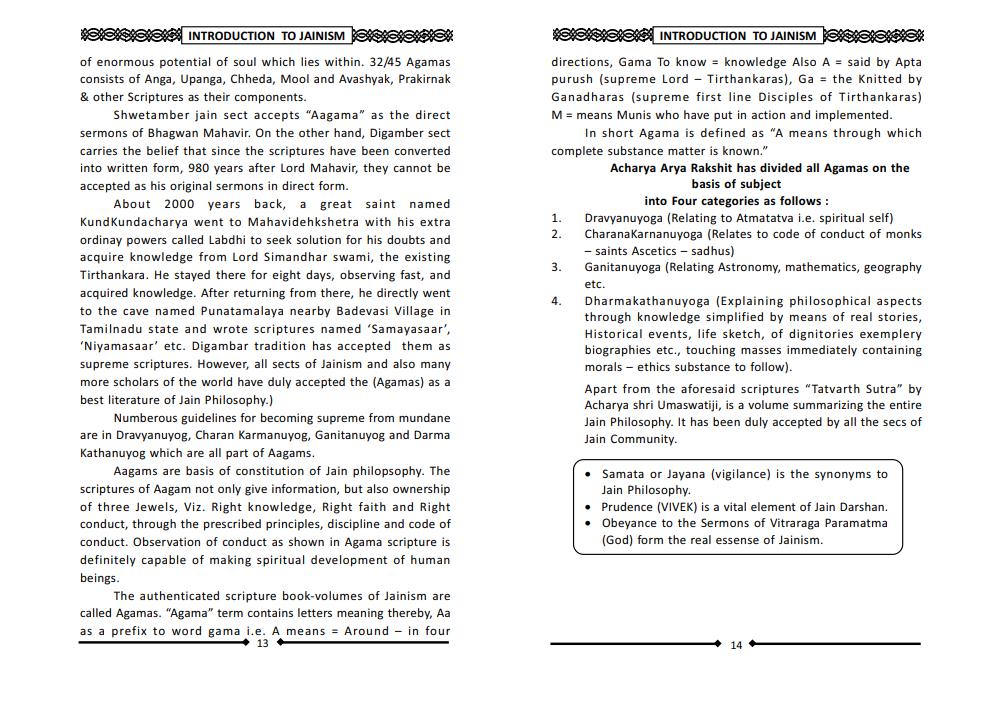________________
$918SISSA. INTRODUCTION TO JAINISMASHABISA of enormous potential of soul which lies within. 32/45 Agamas consists of Anga, Upanga, Chheda, Mool and Avashyak, Prakirnak & other Scriptures as their components.
Shwetamber jain sect accepts "Aagama" as the direct sermons of Bhagwan Mahavir. On the other hand, Digamber sect carries the belief that since the scriptures have been converted into written form, 980 years after Lord Mahavir, they cannot be accepted as his original sermons in direct form.
About 2000 years back, a great saint named Kund Kundacharya went to Mahavidehkshetra with his extra ordinay powers called Labdhi to seek solution for his doubts and acquire knowledge from Lord Simandhar swami, the existing Tirthankara. He stayed there for eight days, observing fast, and acquired knowledge. After returning from there, he directly went to the cave named Punatamalaya nearby Badevasi Village in Tamilnadu state and wrote scriptures named 'Samayasaar', 'Niyamasaar' etc. Digambar tradition has accepted them as supreme scriptures. However, all sects of Jainism and also many more scholars of the world have duly accepted the (Agamas) as a best literature of Jain Philosophy.)
Numberous guidelines for becoming supreme from mundane are in Dravyanuyog, Charan Karmanuyog, Ganitanuyog and Darma Kathanuyog which are all part of Aagams.
Aagams are basis of constitution of Jain philopsophy. The scriptures of Aagam not only give information, but also ownership of three Jewels, Viz. Right knowledge, Right faith and Right conduct, through the prescribed principles, discipline and code of conduct. Observation of conduct as shown in Agama scripture is definitely capable of making spiritual development of human beings.
The authenticated scripture book-volumes of Jainism are called Agamas. "Agama" term contains letters meaning thereby, Aa as a prefix to word gama i.e. A means = Around - in four
S4919/9/6) INTRODUCTION TO JAINISM SKAISEKS directions, Gama To know = knowledge Also A = said by Apta purush (supreme Lord - Tirthankaras), Ga = the Knitted by Ganadharas (supreme first line Disciples of Tirthankaras) M = means Munis who have put in action and implemented.
In short Agama is defined as "A means through which complete substance matter is known." Acharya Arya Rakshit has divided all Agamas on the
basis of subject
into Four categories as follows: 1. Dravyanuyoga (Relating to Atmatatva i.e. spiritual self) 2. CharanaKarnanuyoga (Relates to code of conduct of monks
- saints Ascetics - sadhus) Ganitanuyoga (Relating Astronomy, mathematics, geography etc. Dharmakathanuyoga (Explaining philosophical aspects through knowledge simplified by means of real stories, Historical events, life sketch, of dignitories exemplery biographies etc., touching masses immediately containing morals - ethics substance to follow). Apart from the aforesaid scriptures "Tatvarth Sutra" by Acharya shri Umaswatiji, is a volume summarizing the entire Jain Philosophy. It has been duly accepted by all the secs of Jain Community.
• Samata or Jayana (vigilance) is the synonyms to
Jain Philosophy. • Prudence (VIVEK) is a vital element of Jain Darshan. • Obeyance to the Sermons of Vitraraga Paramatma
(God) form the real essense of Jainism.
14




